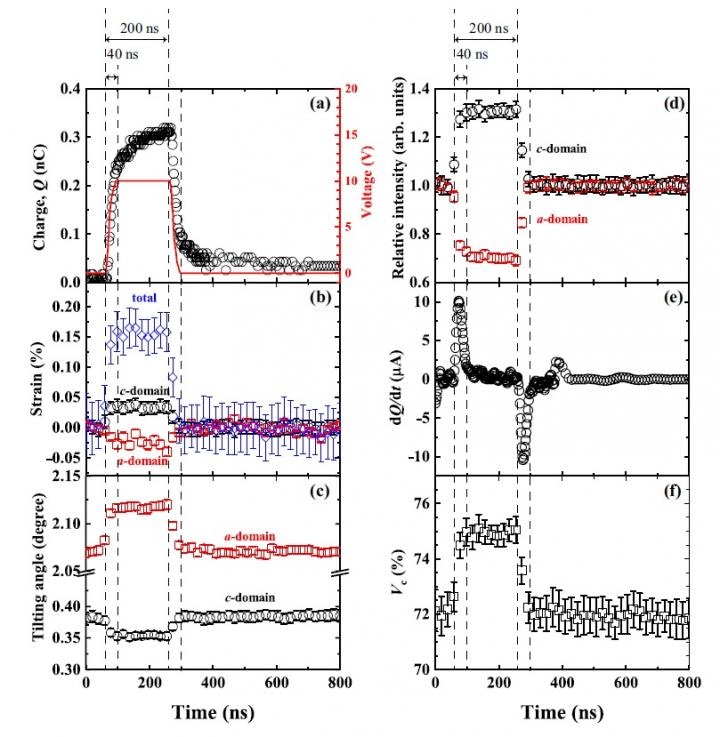Aug 30 2017
High-speed sub-microsecond ferroelastic domain switching and simultaneous lattice deformation are directly observed for the Pb(Zr0.4Ti0.6)O3 thin films unlike the slow ferroelastic domain switching expected for ceramics. This exciting discovery makes way for high-frequency ultrafast electromechanical sensors and switches.
 The (a-f) capacitance, strain, tilting angle, intensity, difference capacitance, and volume fraction of the c domain were measured as functions of time, respectively. The elastic deformation and ferroelastic domain switching were completed within 40 ns. CREDIT Scientific Reports
The (a-f) capacitance, strain, tilting angle, intensity, difference capacitance, and volume fraction of the c domain were measured as functions of time, respectively. The elastic deformation and ferroelastic domain switching were completed within 40 ns. CREDIT Scientific Reports
Piezo micro electro mechanical systems (piezoMEMS) are miniaturized devices that display piezoelectricity, referring to the appearance of an electric charge under applied mechanical stress. These devices are available with a variety of applications in switches, inkjet printer heads, sensors, micropumps, energy harvesters and so on. Ferroelastic domain switching majorly affects the piezoelectric properties in permanently polarized (ferroelectric) materials, and it is possible to exploit this behavior for piezoMEMS applications.
Pb(Zr1-xTix)O3 (PZT) thin films are available with exceptional ferroelectric and piezoelectric properties; thus, they are considered to be prospective candidates for MEMS applications. Both 90° ferroelastic domain switching and lattice elongation are observed in tetragonal PZT thin films under an applied electric field. Non-180° ferroelastic domain switching particularly has vital implications for the future awareness of high-performance piezoMEMS devices.
However, the speed of this 90° domain switching was unknown before the recent investigation. The relationship between the speeds of the lattice deformation and ferroelastic domain switching is yet to be determined. The team, headed by Hiroshi Funakubo, investigated these speeds by examining the switching behavior of Pb(Zr0.4Ti0.6)O3 thin films under applied rectangular electric field pulses.
The changes in the domain structure and the lattice were observed by performing time-resolved in situ synchrotron X-ray diffraction in synchronization with a high-speed pulse generator. These observations were executed at the BL13XU beamline at the SPring-8 synchrotron radiation facility. Through Pt top electrodes, which were fabricated on top of the films, the electric field pulses were applied to the PZT thin films.
Elongation of the surface normal c-axis lattice parameter of the c-domain was revealed, through the investigation of the diffraction peaks in the PZT thin films, with a simultaneous decrease in the surface normal a-axis lattice parameter of the a-domain under the applied electric field. Change was also observed in the intensities of the diffraction peaks under the electric field. Direct evidence of 90° domain switching was provided by these observations.
The lattice elongation and domain switching behaviors were plotted as functions of time in order to determine the switching speed. These plots showcased that these processes were completed within 40 ns and happened simultaneously as a response to the applied electric field. The switching behavior also proved to be flawlessly repeatable.
The present electrical equipment limited the high-speed switching noted in these experiments, however, it is faster than that reported in earlier studies. This high-speed 90° switching is also reversible and can be used for improving the piezoelectric response in piezoMEMS devices by several tens of nanoseconds. Thus, this discovery is considered to be extremely vital for the current development of ultrafast electromechanical sensors and switches.